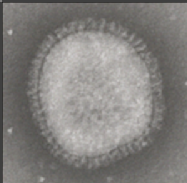Influenza Research
Influenza viruses are a major cause of morbidity and mortality around the world. Influenza A and B viruses are both responsible for annual winter epidemics of flu, whereas the avian influenza viruses which have led to pandemic flu in the past are subtypes of influenza A virus. Currently of concern is the H5N1 subtype, which has the potential to mutate or recombine to make a pandemic strain.


Influenza A virus EM, and cartoon showing the 8 gene segments and the major surface glycoproteins
Vaccines against influenza tend to be very strain-specific, while antiviral drugs (such as Tamiflu and Relenza) tend to be more broadly cross-reactive. There is a clear need for more anti-influenza reagents. In collaboration with Prof. Nigel Dimmock, we are investigating the use of defective interfering influenza viruses as antiviral agents. Some preparations of defective virus can protect mice and ferrets against influenza disease. Cloned defective RNAs can be introduced into viruses, and some of these have strong protective activity.

Defective RNA 1 can replace the full-length gene to make a defective virus
Our group aim to:
- determine the mechanisms of protection using cloned defective RNAs.
- develop the most active protecting RNAs as antiviral agents for human use.
The resulting 'protecting viruses' would have the following advantages:
- Broadly cross-protective against any influenza A virus (including H5N1)
- Unable to replicate by itself, so no disease-causing potential
- Delivered intra-nasally
- Active immediately, and extended period of protection after inoculation
- Converts a subsequent influenza virus infection into an immunising infection
